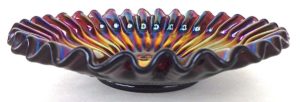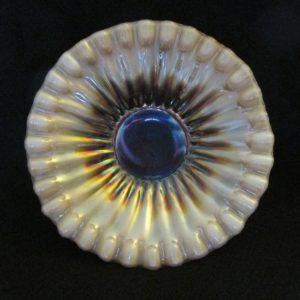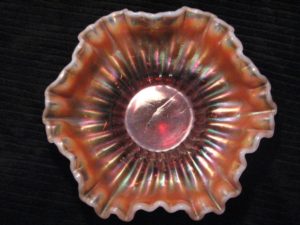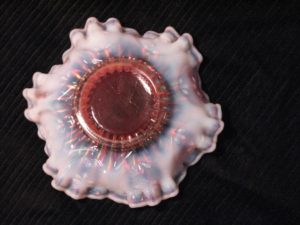by Dr. Larry Keig
That Smooth Rays would find its way on a collector’s Top Ten (or Top One Hundred) list of choice patterns is unthinkable. Dugan’s has an edge over other companies’ similarly named designs because its Jeweled Heart exterior is among carnival’s most elegant secondaries. Besides, the color of Dugan’s can be stunning and the shapes beguiling.
The interior of large Dugan Smooth Rays bowls is made up of 30 highly embossed concave ribs. The rays cover the entire surface except for an unpatterned area directly above and within the confines of the collar base. There are 28 to 30 rays on the upper surface of small bowls, plates, and baskets. All large bowls have a 38-rayed star pressed into the underside of the base. Small bowls have either a 24-rayed star carved into the bottom of the base or a plain base. All plates appear to have unpatterned bases. The outer edge is serrated.
The ornately cast Jeweled Heart back is also found on the reverse of Dugan’s collar-base Cherries, Farmyard, Petal and Fan, and once in a while collar-base Ski Star. Its key features are: (a) highly embossed outlines of eight hearts, (b) “jewels” that dangle like glittering pendants from the points at which the ventricles converge and rise like tied down, helium inflated balloons from the tucks at the base of the hearts, and (c) tiny beads which follow the interior contour of the hearts and jewels. Jeweled Heart is used as a primary pattern on water sets in marigold as well as a back pattern.
Smooth Rays are also a prominent element of other Dugan primary patterns: Caroline, where it is the only element on the top surface, and on Stippled Flower, where it appears on the interior along with the center blossom. A different pattern, sometimes called Sharp Rays, is found on the face of Single Flower Framed items.
Based on the reported colors and the other patterns on which its secondary is found, Smooth Rays/Jeweled Heart is likely exclusively Dugan. There is no indication it was made after the firm was restructured as the Diamond Glass Company in July 1913.
Westmoreland, Fenton, and Northwood also produced Smooth Rays designs. Dave Doty describes these patterns in his Field Guide and at his website. It is possible Diamond or other firms made the even simpler rayed patterns.
Conventional Shapes
The most available shapes are six- and eight-ruffled bowls and small plates with tightly-crimped edge. Ruffled bowls are available in large and small sizes, crimped plates only in a small size. Small tightly-crimped bowls are also available, but seen less frequently.
Large ruffled bowls range from ten and one-half to eleven inches in diameter and stand from three to three and five-eighth inches tall. The eight-ruffled are deeper than the six-ruffled. The eight-ruffled are, in my opinion, more pleasing to the eye than the six-ruffled because all the heart medallions are situated within the folds of ruffles and because the depth makes visible the hearts and jewels.
The reported colors are peach opalescent and amethyst, the former seen more often. The surface color of the peach opal ranges from an anemic apricot or pale peach to a radiant Sunkist orange. The base color of the amethyst runs from a transparent, almost lavender shade to a deep purple plum. More often than not, the Jeweled Heart secondary is uniridized. The amethyst and purple with electric or multicolor iridescence are without question the most sought.
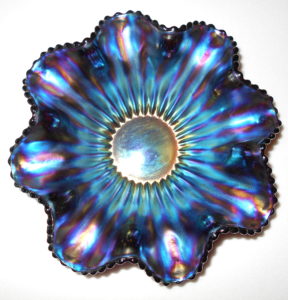
Illustrated is a spectacularly iridized and exquisitely shaped large eight-ruffled bowl in purple from the collection of Bob Preseau of Orwell, Vermont. It measures ten and one-half inches in top diameter. It stands three and one-half inches at its tallest point, two and one-fourth inches at the fold. Bob is a forty-plus-year carnival collector who specializes in Imperial and other firms’ purple and is a long-time NECGA member.
The small bowls are, like the large, found six- and eight-ruffled. Their top diameters range from six to six and one-half inches, and they stand from one and one-half to just under two inches tall. Peach opal and amethyst are the confirmed colors, the two seen in about equal numbers. I am surprised they have not been reported in marigold and white.
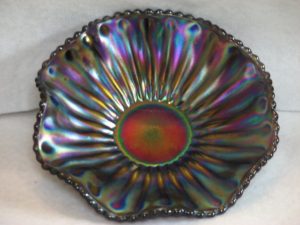
The top diameter of the pretty small eight-ruffled amethyst bowl pictured is six and three-eighth inches. It stands one and one-half inches tall. It has the star on the underside of the base. Its owners are Neal and Sue Becker from Davenport, Iowa.
Crimped-edge plates measure from six to six and three-fourth inches in top diameter, two and three-fourth inches in base diameter. The flatter they are, the greater their top diameter. The dazzling amethyst pictured, owned by Kate and Bill Lavelle from Illinois, is about as flat as they come. It is six and three-fourth inches in diameter and stands one and three-fourth inches tall at its highest point, one and one-half inches tall “in the valleys.”
The nice peach opal shown, from Hoosiers Carl and Eunice Booker’s collection, is six and one-half inches in diameter at its zenith, one and one-eighth inches at its nadir. The underside of the base of both plates is plain. Their Jeweled Heart exteriors are, like most, uniridized.
The tailoring of the illustrated crimped-edge peach opal bowl, also from the Becker collection, is noteworthy in that it has one crimp for each of its 30 interior rays, rays and crimps perfectly aligned, indicating just how carefully some Dugan pieces were crafted. The top diameter is six and three-eighth inches, and it stands one and three-fourth inches tall. The underside of the base is plain, not starred.
Seldom Seen Shapes
All reported out-of-the-ordinary shapes are peach opal pieces produced from a small mold. All have a star embedded in the bottom of the base. They are alluring shapes that collectors can buy at nominal cost.
Banana-Shape Bowl. Ruffled and tightly-crimped banana-shape dishes, with two opposite sides pulled in, measure from six and one-half to seven inches in length and from three and five-eighth to four inches at the tightest point of the told. They stand about one and three-fourth inches tall. Most exhibit a dark orange surface color with plenty of opalescence. Banana bowls, while scarce, are not as difficult to find as once believed.
Basket in Metal Frame. A tightly-crimped banana-shape bowl is also available as part of a two-piece basket. In baskets, the bowl is set in a fancy metal frame with arched handle.
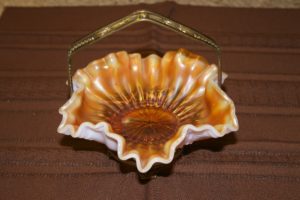
The bowl of the illustrated basket measures six and three-fourth inches from end to end and five inches at its waist. The girth of the basket’s bowl is greater than that of typical banana bowls, indicating that it was configured to fit snugly in the holder and that not just any banana bowl will do. In frame, the basket stands six inches tall. It sold on an eBay auction a few years back.
Other Dugan bowls set in metal frames—like large collar-base Ski Star, mid-size Daisy Dear, and small deeply ruffled Fishscale and Beads, and ruffled and tightly-crimped banana-shape Petal and Fan/Jeweled Heart—also occasionally surface. Frames for baskets or condiment containers of this type were outsourced by the firm, not in-house produced. These baskets were marketed in small quantities, probably as novelty or niche items, from roughly late 1910 through 1911.
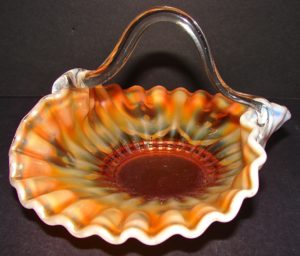
Basket with Separately Attached Handle. The tightly-crimped (but not ruffled) banana-shape basket with separately attached, clear crystal handle is unique among Dugan’s carnival baskets in that the handle is V-shaped rather than rounded or looped. The V-shape handle, however, is known to have been used by Dugan in pre-carnival basket production.
These baskets range from six and one-fourth to seven inches in length and from four and one-fourth to five inches wide where the handle is attached. They range in height from three and three-fourth to four and one-half inches. Their base diameter is two and three-fourth inches. Baskets like this are susceptible to damage where the handle was fused to the bowl.
This basket, while scarce, is more available than once thought, suggesting it was a line item. It is a highly desirable shape but rarely brings much money when sold. That’s likely because the surface color and iridescence are hardly ever what can be described as lush. It is intriguing to think about what one in vivid orange would bring.
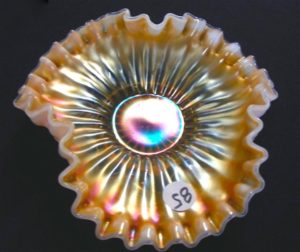
Tri-Cornered Bowl. The tightly-crimped tri-cornered bowl is an uncommon shape in the pattern but is not a bona fide whimsey because it is anything but an unusual or “strange” shape. The illustrated piece sold at Mickey Reichel’s April 2, 2016, auction in Booneville, Missouri. It is six inches from one end to the other and one and seven-eighth to two and one-fourth inches tall, height dependent on where the measurement was taken on the perimeter. It has 30 rays on its top side. Dave Doty has reported that another sold in 2015.
Handgrip Plate. Dave also reported the 2015 sale of a peach opal handgrip plate. Because it brought but $15, it must have been ugly as a mud fence or made by Westmoreland or another of Dugan’s competitors.
I extend thanks to collectors who have provided photos, descriptions, “counts,” and other information: Neal Becker, Carl Booker, Barb Chamberlain, April and Kevin Clark, Kate Lavelle, Bob Preseau, and Mickey Reichel. Without their help, an article like this would be difficult, if not impossible, to put together.
Larry.Keig@cfu.net

